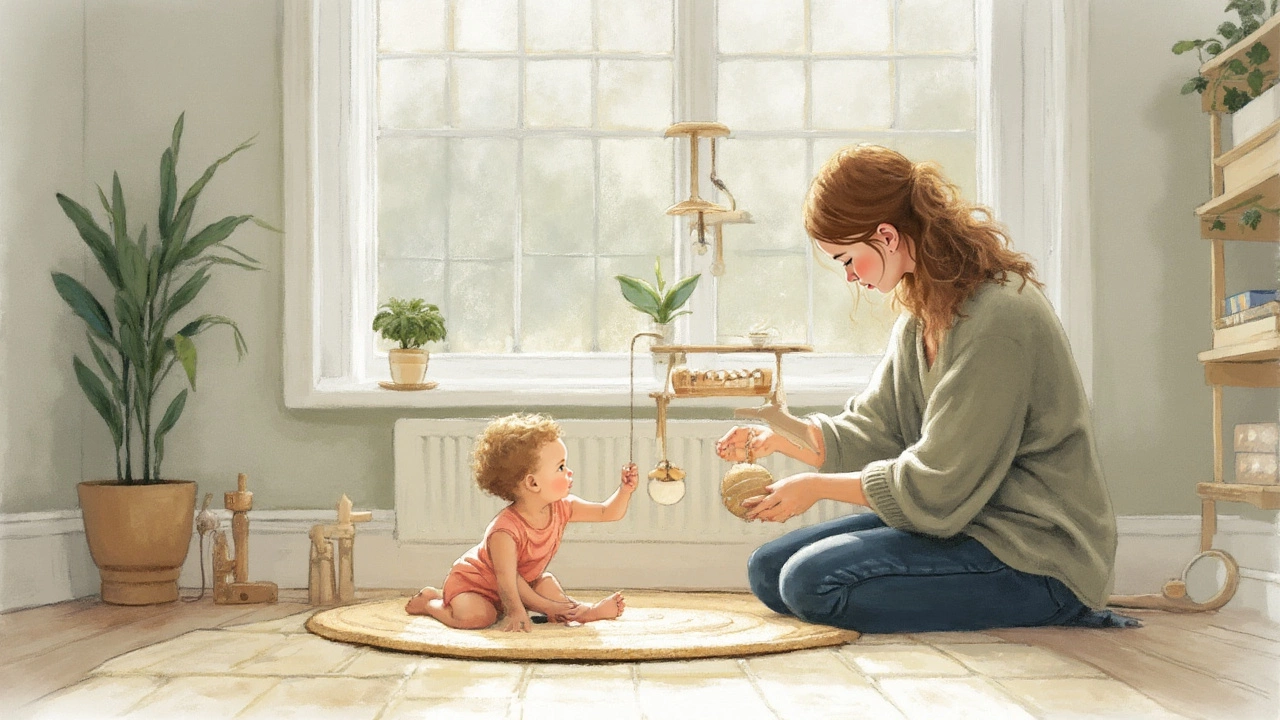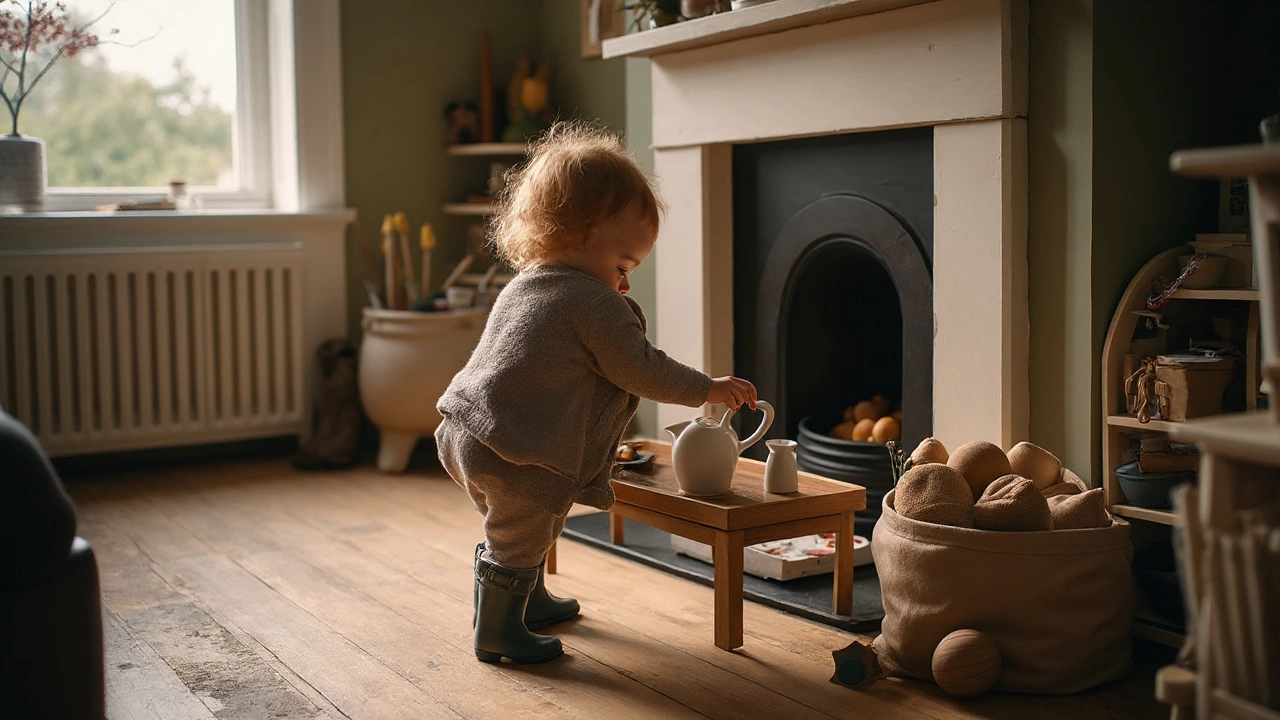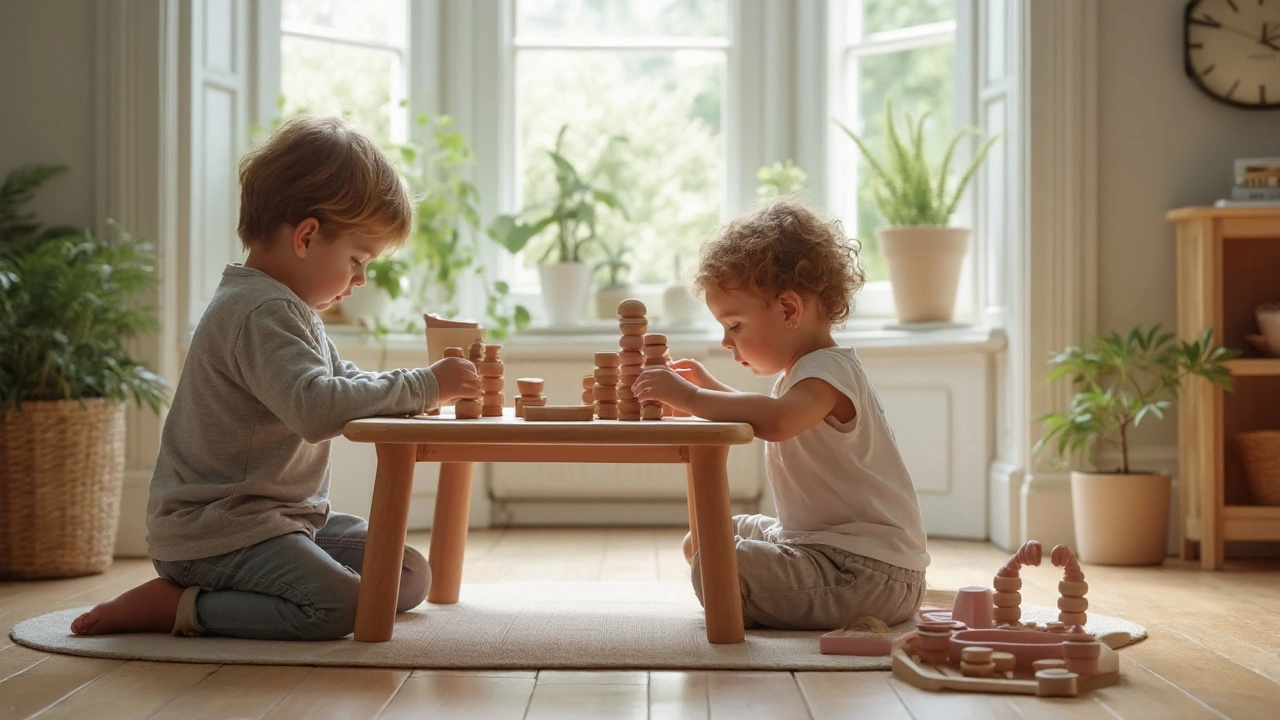What Age Is Right for Montessori Toys? Age-by-Age Guide for Babies, Toddlers, and Preschoolers

You clicked this because you want a straight answer: when can my child start using Montessori toys, and which ones actually make sense at each age? Here’s the promise-clear age ranges from birth to 6 years, easy readiness cues, safety notes you can trust, and a simple way to choose, introduce, and rotate toys without turning your living room into a plastic museum.
- Most kids can use Montessori toys from birth through about age 6, with the sweet spot from 6 months to 4 years.
- Pick toys that match skills: movement and grasp (0-12 months), posting and simple puzzles (12-24 months), sequencing and pre-academics (2-4 years), and deeper math/language (4-6).
- Safety first: avoid small parts under 3, high-powered magnets, and button batteries; stick to sturdy, non-toxic materials (ASTM F963/EN71). Source: AAP and CPSC guidance.
- Use the 5S test: Safe, Simple, Self-correcting, Single skill, Sized right.
- Show once, then step back. Observe. Rotate 6-8 items on a low shelf every 1-2 weeks based on your child’s interest.
Age-by-age guide: what to offer from birth to 6 years (and why)
Montessori lives in the “first plane of development”: birth to 6 years. That’s where kids crave order, movement, and language (Dr. Maria Montessori called this the “absorbent mind”). You’ll see “sensitive periods” for things like hand use, tiny details, and social language pop up and fade. When a toy meets a current sensitive period, it feels magnetic-your child naturally repeats it, then moves on. That’s your cue to rotate.
Below is a practical, home-friendly map. Take ages as ranges, not rigid rules. Always follow your child, not the box label.
| Age | Skill focus | Examples | Readiness signs | Safety notes |
|---|---|---|---|---|
| Birth-3 months | Visual tracking, grasp reflex, head control | High-contrast cards, Munari/Munari-style mobile, lightweight fabric rattle | Calms while watching movement; turns head to light/contrast | Securely hung mobiles out of reach; no cords near sleep spaces |
| 3-6 months | Reaching, batting, two-handed grasp | Grasping ring, interlocking discs, wooden rattle, crinkle cloths | Brings hands to midline; reaches and transfers hand-to-hand | Teethers one piece; avoid gels/liquids; inspect daily |
| 6-9 months | Sit, roll, early crawl; cause and effect | Rolling ball, wobble toy, simple ring stacker (few rings), soft treasure basket | Sits with support; bangs and explores with mouth | No small parts; large diameter rings; supervise treasure baskets |
| 9-12 months | Object permanence, pincer grasp | Object permanence box, coin/posting slot with large coins, ball tracker | Looks for hidden things; picks up bits with thumb and finger | “Coins” too big to swallow; smooth edges; stable frames |
| 12-18 months | One-step actions, hand-eye coordination | Imbucare boxes (single shape), hammer peg, knobbed single-shape puzzles, push cart | Walks or cruises; enjoys repeating the same action | Non-slip bases; short pegs; supervise hammering |
| 18-24 months | Sorting, matching, simple practical life | Two- and three-piece puzzles, shape sorters with few shapes, spoon/scoop transfer, dressing frames with large buttons | Sorts by size/color; imitates chores | Materials bigger than a film canister; watch for mouthing |
| 2-3 years | Order, sequencing, vocabulary explosion | Stacking blocks (gradual size), simple sequencing cards, matching objects to cards, cylinder blocks, practical life kits (water pouring, sweeping) | Lines items up; names many objects; longer focus | Water work on a tray; non-toxic finishes (ASTM F963/EN71) |
| 3-4 years | Pre-reading/writing, early math | Sandpaper letters, moveable alphabet, number rods 1-10, spindle box, metal inset-style tracing | Interested in sounds; enjoys tracing; counts objects in play | Small parts now okay if no mouthing; store away from younger siblings |
| 4-5 years | Place value sense, logical patterns | Golden bead intro set (units/tens/hundreds), bead stairs, pattern blocks, practical life (knife skills with soft fruit, sewing cards) | Groups and compares; asks “how many?” often | Child-safe knives; clear rules; supervised sewing needles |
| 5-6 years | Math operations, reading readiness | Stamp game, hundred board, moveable alphabet word building, puzzle maps, time/clock work | Blends sounds; writes invented spellings; adds small quantities | Small pieces stored high if younger kids visit |
Want a quick sanity check? If your child can complete a toy without focus or effort, it’s too easy-level up. If they throw it, avoid it, or rely on you every step, it’s probably too hard-simplify the task or put it away for a few weeks.
Why these ranges track with development: infant work mostly feeds movement and hand control; toddler work feeds order and two-handed coordination; preschool work weaves in symbols (letters, numbers) after tons of hands-on sensorial experience. This sequence aligns with Montessori’s core texts (The Absorbent Mind) and what pediatric groups like the AAP encourage: real-world exploration over electronic stimulation.

How to choose and introduce Montessori toys at home (simple steps, safety rules, and rotation)
Use this 5-minute method to pick and present toys so your child actually uses them.
The 5S Test (write it on a sticky note):
- Safe: No small parts under age 3; no magnets or button batteries; sturdy joints; non-toxic finishes labeled ASTM F963 or EN71.
- Simple: One clear purpose. No lights, buzzers, or busy extras.
- Self-correcting: The design shows “right” and “not yet” without you stepping in (a cylinder block that only fits one way).
- Single skill: Target one ability at a time-pouring water is just pouring, not color-matching-plus-counting.
- Sized right: Fits little hands; the whole set fits a tray your child can carry.
Safety you can count on:
- Choking risk: For kids under 3, avoid anything that fits entirely in a CPSC small-parts cylinder (about 1.25 in. diameter by 2.25 in. long). When in doubt, do the toilet paper roll test-if it slips through, it’s too small. AAP toy safety updates keep the same bottom line.
- Magnets and button batteries: High-powered magnets and coin cells are a hard no for young kids. If a toy uses batteries, the compartment needs a screw.
- Cords/strings: Keep cords under 7 inches for infants and toddlers to avoid strangulation risks; mobiles are for visual use only and must be out of reach.
- Materials: Solid wood and food-grade silicone are reliable. If painted, look for “water-based, non-toxic” and standard compliance (ASTM F963/EN71). Smooth, rounded edges always.
How to introduce a Montessori toy (2-minute script):
- Clear the space. One tray on a low shelf. No competing toys nearby.
- Model slowly and silently once. Exaggerate your movements; keep your breaths steady. Kids learn by watching your hands.
- Invite. “Your turn.” Slide the tray toward your child and step back.
- Observe. Are they repeating? Struggling? Bored? Resist rescuing; offer the smallest possible help (like pointing, not doing).
- Close with care. When interest fades, demo how to return the toy to the tray and the tray to the shelf. That’s the “control of movement” piece Montessori loved.
Rotation without the headache:
- Put out 6-8 activities your child can use independently. That’s it.
- Swap 1-3 items every 7-14 days-or sooner if a toy is ignored for 3 days straight.
- Keep a small storage bin out of sight. Label by skill (posting, pouring, puzzles) so you balance the shelf.
- Follow new skills. When you see a new trick-zipping, counting objects, tracing-add something that stretches it a little.
Starter kits by age (home-friendly, budget-aware):
- 0-6 months: Contrast cards, a simple mobile, a grasping ring, and a soft rattle.
- 6-12 months: Ring stacker (3 big rings), ball tracker or ramp, object permanence box.
- 12-24 months: Single-shape knob puzzle, posting box, hammer peg, scoop-and-transfer tray, child-sized broom.
- 2-3 years: Cylinder block, 3-5 piece wooden puzzles, matching cards with objects, water pouring set, dressing frame.
- 3-4 years: Sandpaper letters, number rods or bead bars 1-10, moveable alphabet, tracing insets, tong transfer with pom-poms.
- 4-6 years: Bead stairs and simple golden bead set, hundred board, puzzle maps, word-building with the moveable alphabet.
DIY swaps that work (and don’t look like a craft fail):
- Object permanence: Metal mixing bowl upside down with a cut slot + wooden “coins” cut from a dowel (oversized). Sand edges smooth.
- Pouring: Two small glass creamers on a tray with dry rice first, then colored water. Add a sponge for spills to teach cleanup.
- Sorting: Muffin tin + large pom-poms. Add tongs at 2.5-3 years for challenge.
- Language objects: Gather 10 tiny household items (cap, nut, peg, lid…) and matching photo cards you print at wallet size.
- Practical life: Child-sized spray bottle with water + small squeegee for windows; a real whisk to make foamy soap in a bowl.
When a toy is “genuine Montessori” vs “Montessori‑ish” marketing:
- Genuine classroom materials: Pink Tower, Broad Stair, Cylinder Blocks, Sandpaper Letters, Bead Material. These are precise, sequenced tools used by trained guides.
- Montessori‑inspired toys: Simpler, home-ready versions that isolate one skill (a basic ring stacker, single-shape puzzles). These are great at home.
- Skip: Loud panels with lights and buttons, busy multi-skill contraptions, and sets that force pretend scripts. Montessori favors open, real, and purposeful.
How this lines up with research you can trust:
- The American Academy of Pediatrics emphasizes hands-on, caregiver-interactive play and warns against electronic toys for learning in early years. Toy safety (choking, magnets, batteries) is unchanged in recent AAP and CPSC advisories.
- CDC developmental milestones (updated through 2024-2025) match the skill ranges here-think pincer grasp by around 9-12 months, simple two-step play by 2 years, pre-reading signs closer to 3-4 years.
- Montessori’s first plane (0-6 years) and sensitive periods are well-documented in primary texts (The Absorbent Mind) and by AMI/AMS training guidelines.

Quick answers, checklists, and next steps
Here’s where we tie off the loose ends parents usually ask after they set up a shelf.
FAQ you probably have:
- Can newborns use Montessori toys? Yes, for visual and auditory exploration. Think mobiles hung safely out of reach and high-contrast images. Keep it calm and brief.
- Are Montessori toys only wood? No. Montessori is about function, not aesthetics. Silicone, metal, fabric-if it’s safe, simple, and purposeful, it fits.
- We missed the baby stage-can we start at 3 years? Absolutely. Start with practical life and sensorial work, then add letters/numbers when your child shows interest in sounds and counting.
- How many toys should be out? Six to eight activities your child can use independently, plus a few books and one gross-motor option.
- Do we need official classroom materials? Not at 2. The big, formal sets shine from ~3.5 years on (letters, numbers). Before then, home-friendly “inspired” toys are plenty.
- My toddler throws the puzzle pieces. What now? That means it’s too hard or they need a movement break. Offer a simpler insert (one shape), try a gross-motor reset, or shelve it for a week.
- Is screen time okay with Montessori? Montessori didn’t design for screens. AAP suggests avoiding screens under 18 months (other than video chat) and keeping it limited and high-quality after that. Hands-on beats apps for learning.
- What about neurodivergent kids? Follow your child’s sensory needs. Some may seek heavy work or quieter visuals. Shorter demos, more repetition, and choice of textures help. An OT can tailor great practical life work.
Age-by-age mini checklists (print and tape inside a cabinet):
- 0-12 months: One mobile or visual; one grasp toy; one rattle; one ball; one basket to explore; a floor mirror if you have space.
- 12-24 months: One posting work; one puzzle; one transfer; one hammer or ring stacker; one push/pull; one practical life (broom/sponge).
- 2-3 years: One sorting/matching; one sequencing; one water work; one dressing frame; one cleaning job; one building work.
- 3-4 years: One letter tray; one number tray; one tracing work; one practical life challenge (peeling/cutting); one sensorial (cylinder, size blocks).
- 4-6 years: One bead math; one word-building; one map or science tray; one fine-motor craft (sewing, weaving); one responsibility (plant care).
Common pitfalls (and easy fixes):
- Too many toys out: Kids ping-pong between options. Fix: cap the shelf at 6-8 works.
- Activities too advanced: Frustration turns into throwing. Fix: back up one step-fewer pieces, larger knobs, or a shorter sequence.
- No clear place to return: Toys scatter. Fix: every activity lives on a tray/basket; label with a photo at 2+.
- New baby and an older sibling: Small parts migrate. Fix: store 3+ work in a latch box or on a higher shelf; offer the toddler a parallel, chunky version.
- Small apartment: Vertical shelf, trays that stack, and one basket for gross motor (ball, jump rope) you pull out daily for 10 minutes.
Scenarios and what to do:
- Gift-buying for a 1-year-old you barely know: Go with a posting box with oversized coins or a single-shape knob puzzle. Safe, developmentally right, under $30, and it gets used.
- Twin toddlers: Duplicate high-demand works (pouring, posting) but vary puzzles to encourage taking turns and trading.
- Tight budget: Choose 3 anchors: posting box, 3-5 piece puzzle, pouring set. DIY the rest (sorting, language objects, treasure basket).
- No time for rotation: Put a reminder in your phone for the first Saturday of the month. Swap two trays and add one new book. Done.
- Child resists clean-up: Make it a sequence game: “Tray, shelf, clap.” Start with just three items out until the habit sticks.
Ready for simple next steps?
- Pick one age-true activity from the table above and set it on a tray today.
- Model it once, then write down what your child does for five minutes. That observation will tell you what to add next.
- Block 10 minutes next weekend to rotate 2-3 items. Keep your shelf at eye level for your child and everything reachable.
- Bookmark reliable standards on the products you buy: look for ASTM F963/EN71, and avoid magnets/batteries unless sealed with screws.
- When in doubt, simplify. If you’re choosing between “more pieces” and “one clear step,” choose the one clear step.
The short answer to your question-what age is appropriate for Montessori toys? From day one to about age six, if you match the toy to the skill your child is hungry to practice. If a toy invites calm focus and repeat use, you nailed the timing.